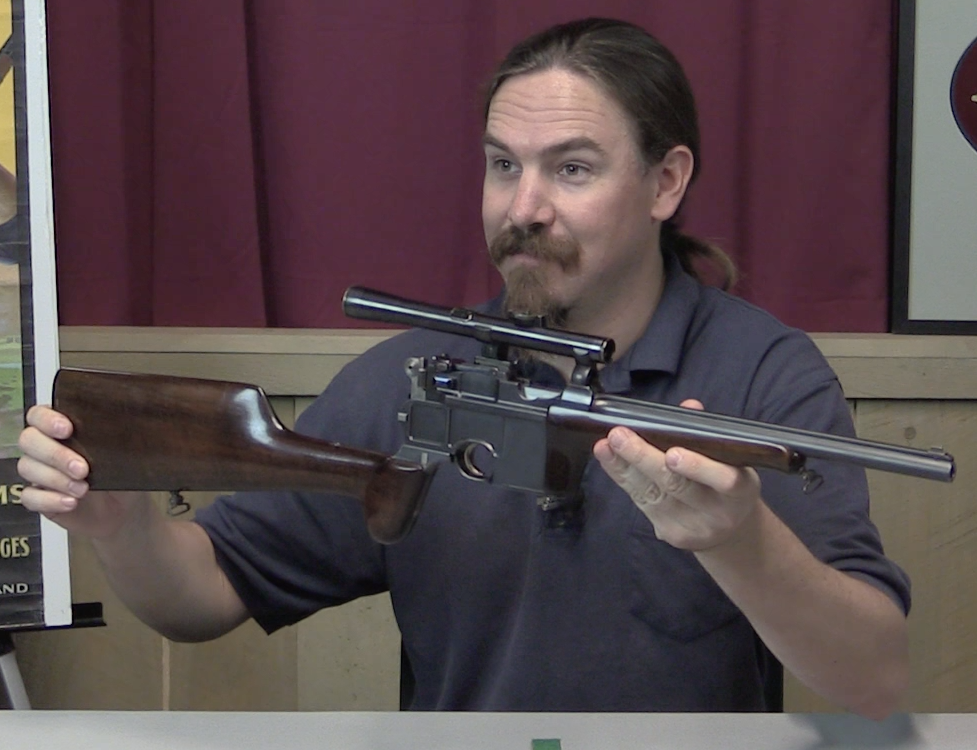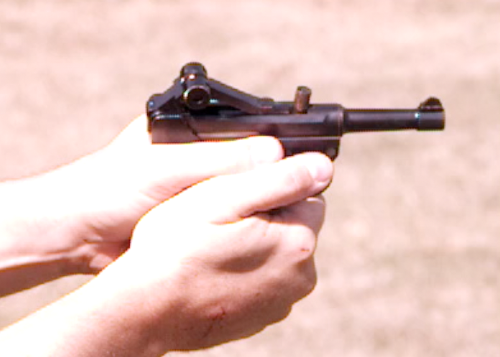The German FG-42 paratroop rifle was a very impressive design, managing to meet a very strict set of performance criteria. The first production model in particular was exceptionally light and compact, while still offering semi and full-auto 8mm Mauser fire with surprisingly light recoil. The gun went through a continuous evolution through its production, becoming heavier and less expensive to manufacture. The first major design was made from a milled billet of steel at great cost, and the second major model was done with a stamped steel receiver instead. We had the opportunity to disassemble one of the second model FG42s, and put together a video showing how it operates:
You can read more on the development of the gun over on the FG-42 page in the Vault, where we also have a gallery of detailed photos.




Great video! keep up the stellar work! need good images of that FG-42.
Great video. Very informative. Its a shame it is deactivated. It is like saying , ‘Yes you can have this racehorse. But it has to be stuffed and mounted’, or ‘You can have this car, just without the engine’.
Very interesting snippet on the M60 firing pin spring.
As I’m sure you guys already know, another feature that was lost on the 2nd model gun was the clip guide for reloading a mag on the gun using the standard K98 clip. Ever quaint, us Brits tried to add that to our version of the FAL – you can see them in photos from operational troop trials in the mid ’50s.
Very cool to see a FG42 and how it works. there are a few examples of these in New Zealand and I have had the privilege of holding one once ( captured in Italy along with a paratrooper helmet).
Really would love to see you shooting one however. Always been curious how usable it was on full auto.
Looks to me like a variant of the Johnson Light Machinegun. Very similar butt and magazine mount. The Johnson also had a clip guide. I’m not familiar with the insides of the Johnson.
Not sure that there’s any direct link, more like convergent evolution.
Very interesting video — thanks, Ian! It was equally interesting and not a little surprising that the article states that the FG-42 had “surprisingly light recoil” in the fully automatic mode, because one of the major concerns expressed by the German Army at the time was that the relatively light weight (14.5 lbs.), combined with the muzzle energy of the 7.92 x 57mm cartridge, resulted in a weapon that was difficult to fire accurately in full auto, and it was generally acknowledged that it took a very well-trained soldier to get the most out of the FG-42.
The end result of all this was that it was adopted by the Luftwaffe’s elite paratroops, who had the necessary skill levels to use the FG-42 effectively, while the Army went on to develop and adopt the StG-43 and -44 assault rifles firing the more manageable 7.92 x 33mm Kurz cartridge.
Is it possible that the inherent rivalry between the two services was part of the reason for this divergence, rather than purely technical and performance-based considerations? Stranger things in this vein have often happened, even in the middle of a war and all its exigencies.
I am sure that some of our fellow contributors will have additional information that will shed light on this subject.
The FG 42 was a pure Luftwaffe development for the paratroopers. The army (Heereswaffenamt) was not involved at all and did its best to kill the gun.
Keep in mind that at the time German paratroopers did jump without their K98k rifles and machingeuns. These were dropped in containers separately. Seems unbelievable today, but that was the way it was done.
The goal of the FG 42 was to have a weapon that the paratroopers could jump with and that could serve as rifle as well as light machine gun.
Awesome gun, really a shame it was deactivated…nevertheless great video
Yeah, it really is a shame…and the alternative was to destroy it completely or surrender it to ze authoritah. The silver lining is that the demil is relatively mild by US standards, which would have required torch cutting the receiver into a bunch of little slagged-up pieces.
Just like MP38 at beginings,
MP38 was Erma not Schmeiser made,besides its features Volmer telescoping recoil mechanism so basicly MP38/40 is Erma-Volmer design,MP41 is pure Schmeiser design adoptation between MP40 and MP18 or 28 bases and simply murged together…
Now MP38 is entirely differant from MP40,first at all milling process which was very expansive to manufacture those guns,even trigger frame was milled entirely…
MP40 was recquired only sheetmetall stamping and spot welding,MP40 trigger frame is made of sheetmetall so as lower buffer housing…
Same stages was with FG42,first FG42 model was mostly milled even housing,2nd and third models main housing was sheetmetall stamped and barrel trunion was inserted and usualy spot welded in…
The 2nd FG42 model trigger housing was made in differant design so as grips,cocking handle was differant too, thats was improvemants to reduce machining work and build guns from sheetmetall…
Honestly FG42 is something unseen,a true piece of art and like Ian added FG42 was main base for develop M60 machine gun,M60 is reassemblance between FG42 and MG42 trigger mechanism so as feeding mechanism for belts..
As we all seen M60 prototype Manual thanks again to ian we see thats first designs was much symphatetic than furter ones,I cannot say thats M60 was well designed still later models had rework and further improvemants than standart M60 model…
For instance first M60 model barrel had indevidual bipod attached,so you taking barrel off and bipod caming out with it,thats cost too many critics during Vietnam war,those complains came from infantry and later model was called MK2 where barrel was attached to main housing instead…
Nice video.
There actually is a semi automatic copy.
http://hza-kulmbach.de/index.php?option=com_content&view=article&id=108&Itemid=135&lang=en
That gun is made in Germany – when they have an importer and ATF approval on the design and we can see how the QC is, then it might be worth getting excited about.
These guys here work on semi-auto reproductions, albeit taking quite a few liberties. 8mm uses ZB magazines, and the entire weapon is made of milled steel, rather than sheet metal. They’re developing a .308 version using M1A magazines. With a price of $5000, it isn’t that bad of a rifle, and those that got the first batches seem to enjoy them thus far.
http://smgguns.com/
Still has some kick to it:
http://www.youtube.com/watch?v=ISKnl1OnI9Y&feature=my_favorites&list=FLnamAXbyUg1naET1N597Zeg
Great video on one of the most fascinating dead ends of WWII. It seems strange that someone took it and grafted the MG42 belt feed system to it to make the almost workable M60. Then again, I wonder what Colonel Lewis would have thought of either weapon 😉
I also wanted to say thank you for the clear explanation of the selective fire mechanism. I had never been completely clear on how it fired in semi-auto. It’s especially entertaining to know the reason for that “goddamn” spring in the M60 bolt too.
nice video
would you make a side by side comparison video of the FG-42 and the m60
Ian’s reply of August 6th concerning the less draconian demilitarization of the FG-42 came as a relief — it is still painful to look at offerings here in the United States of Suomi KP-31’s with torch-cut receivers being sold for spare parts.
Don’t breathe too big a sigh of relief – our (UK) post-1995 deac spec for this sort of thing includes cutting the bolt carrier in half, throwing one half away and welding the other to the ejection port! Only the trigger moves (and the mag is usually removable). This one is 1988 – 1995. when moving working parts were permitted.
I had great conversations years ago with a Special Forces vet ( Pre Green Beriet) who was working with the Kurds in the late 1950 S. he said the powers that be were interested in giving them more firepower. Their main weapons were 8 mm Mauser 98 K and earlier Turkish Mauser’s. After WW II the fag’s captured by the U.S. and British forces were stored in The Netherlands (Delft ?) A request for them was put in, and most of that stockpile was delivered to the Kurds. I wonder were they are NOW.
Clearly the people that make comments about the M60 having problems or not working correctly have either never used one.
Or were shit useless and poorly trained as Gunners No complaints here I can assure you.